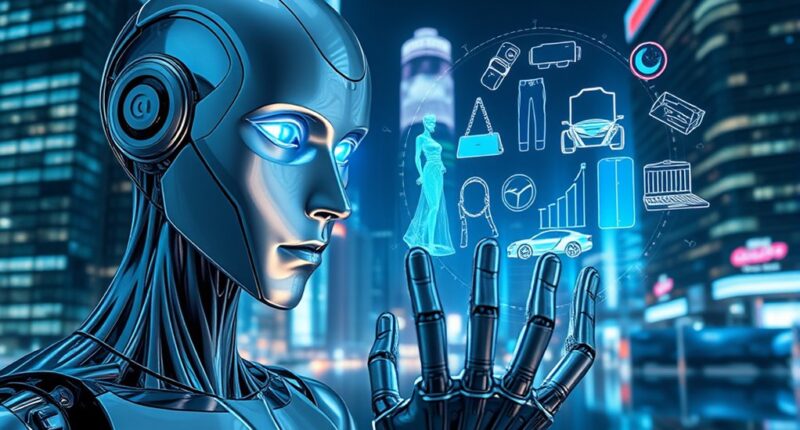Machines now analyze your behavioral and psychological data to understand your desires, often predicting preferences before you’re even aware of them. Using advanced algorithms like random forests, they can forecast what you’ll want next, whether in shopping, entertainment, or relationships. Companies leverage this insight to personalize ads and recommendations, guiding your choices seamlessly. If you stay with us, you’ll discover how these technologies are shaping your experiences and what’s coming next.
Key Takeaways
- AI algorithms analyze behavioral and psychological data to predict human desires before conscious awareness.
- Machine learning models, like random forests, forecast desires with notable accuracy, informing targeted content and offers.
- Desire prediction is used to personalize advertising, products, and services based on real-time behavioral insights.
- Transparent models identify key factors influencing desire, supporting ethical applications in healthcare and social sciences.
- The commodification of desire data enables companies to proactively guide consumer choices and preferences.

Advances in machine learning now enable machines to understand human desire by analyzing behavioral and psychological data. This breakthrough allows algorithms to predict what you want before you even consciously realize it. For example, random forest algorithms can forecast variations in sexual desire with about 40% accuracy, focusing on both partner-related and solitary desires. They identify key predictors like sexual satisfaction and feelings of romantic love for dyadic desire, while solitary desire correlates strongly with masturbation frequency and permissive attitudes toward sexuality. Notably, gender differences are less predictive than relationship factors and psychological states, highlighting the importance of emotional and contextual influences in desire. The concept of the Intention Economy demonstrates how predictive data can be commodified and sold for profit. These insights aren’t limited to personal intimacy. AI assistants now forecast emerging consumer desires before you’re even aware of them, creating what’s called “intention economies.” Companies leverage vast pools of intimate behavioral and psychological data to predict your preferences and buying intentions in real time. By doing so, they can proactively target you with personalized ads or offers, often before you’ve consciously formed an intent. These AI agents are designed to mimic human interaction styles, building trust and social influence through “anthropomorphic” behaviors that make interactions feel more natural and engaging. The core of these capabilities lies in machine learning’s ability to detect subtle patterns within enormous datasets containing text, images, audio, and video. The more high-quality data they access, the better their predictions become over time. Labelled data, for instance, helps train models to recognize nuanced behaviors like purchase preferences or emotional states. These models generalize from complex, often hidden, patterns that humans might overlook, giving brands and researchers a powerful tool to anticipate desire in ways we haven’t seen before. This is especially effective in environments with high data volume, such as online shopping platforms or social media interactions, where continuous data flow refines prediction accuracy. Decision tree and random forest models are particularly popular for desire prediction. They classify data by branching on relevant features, then combine multiple trees to produce more reliable results, reducing overfitting and bias. These models handle diverse variables—from psychological traits to behavioral cues—making them versatile tools in understanding human desire. They also offer interpretability by revealing which features most influence predictions, helping clinicians or marketers understand the underlying drivers of desire. In healthcare and social sciences, such transparent models support better decision-making and targeted interventions. Additionally, rule-based machine learning techniques extract explicit, interpretable “desire rules” from data. These rules clarify how specific factors influence desire, offering transparency that’s vital in therapy or counseling contexts. By combining statistical insight with clear logic, AI systems support personalized approaches that respect individual differences. Ultimately, as machine learning continues to leverage vast data and sophisticated models, it’s transforming our understanding of desire—making it more predictable, personalized, and influential in guiding content optimization consumption and social interaction.
Frequently Asked Questions
How Do Machines Interpret Human Emotional Cues Accurately?
You see, machines interpret human emotional cues accurately by analyzing various signals like voice tone, facial expressions, and gestures using advanced AI models. They process acoustic features such as pitch and intensity, while multimodal systems combine data from multiple sources for better understanding. Deep learning techniques like CNNs and RNNs help recognize emotional changes over time, enabling machines to respond more naturally and precisely to your feelings.
What Ethical Concerns Arise From Machines Influencing Consumer Choices?
Imagine a puppeteer subtly pulling strings behind a curtain, guiding your every move. That’s the ethical concern when machines influence your choices. They manipulate vulnerabilities without transparent consent, risking your autonomy. Data privacy gets compromised, biases reinforce unfair treatment, and you may not even realize how your preferences are shaped. This erosion of control raises serious questions about fairness, transparency, and respecting your ability to make independent decisions.
Can Machines Adapt to Changing Human Desires Over Time?
Yes, machines can adapt to changing human desires over time. They analyze real-time data from your social media, purchases, and browsing habits, allowing them to recognize shifts in your preferences. By continuously updating their models, they predict what you’ll want next, enabling personalized recommendations and targeted marketing. This dynamic adaptation helps businesses stay in sync with your evolving needs, making your experience more relevant and engaging.
How Do Machines Differentiate Between Genuine and Manipulated Preferences?
Ever wonder if your choices are truly yours? Machines differentiate genuine from manipulated preferences by analyzing your behavior over time for consistency, and evaluating if your actions align with stable patterns. They utilize behavioral profiles, detect manipulative language or emotional cues, and monitor shifts caused by external influences. By contrasting your baseline engagement with current activity, they identify artificial influences, helping guarantee your preferences genuinely reflect your desires, not external manipulation.
What Impact Does This Technology Have on Human Autonomy?
This technology considerably diminishes your autonomy by subtly steering your choices without your full awareness. You may feel free to decide, but AI systems analyze your behavior and influence your preferences through personalized content and real-time triggers. As a result, your decisions become less about your genuine desires and more shaped by predictive algorithms, limiting your ability to make truly independent, informed choices and reducing your control over consumption.
Conclusion
Imagine a world where machines understand your desires before you even voice them. They’re now guiding your choices, making shopping effortless. Did you know that by 2025, it’s estimated that 80% of consumer interactions will be managed by AI? That means your preferences are becoming more precise, almost like having a personal shopper who knows you better than you know yourself. This shift isn’t just convenient—it’s redefining how you experience and fulfill your desires daily.









